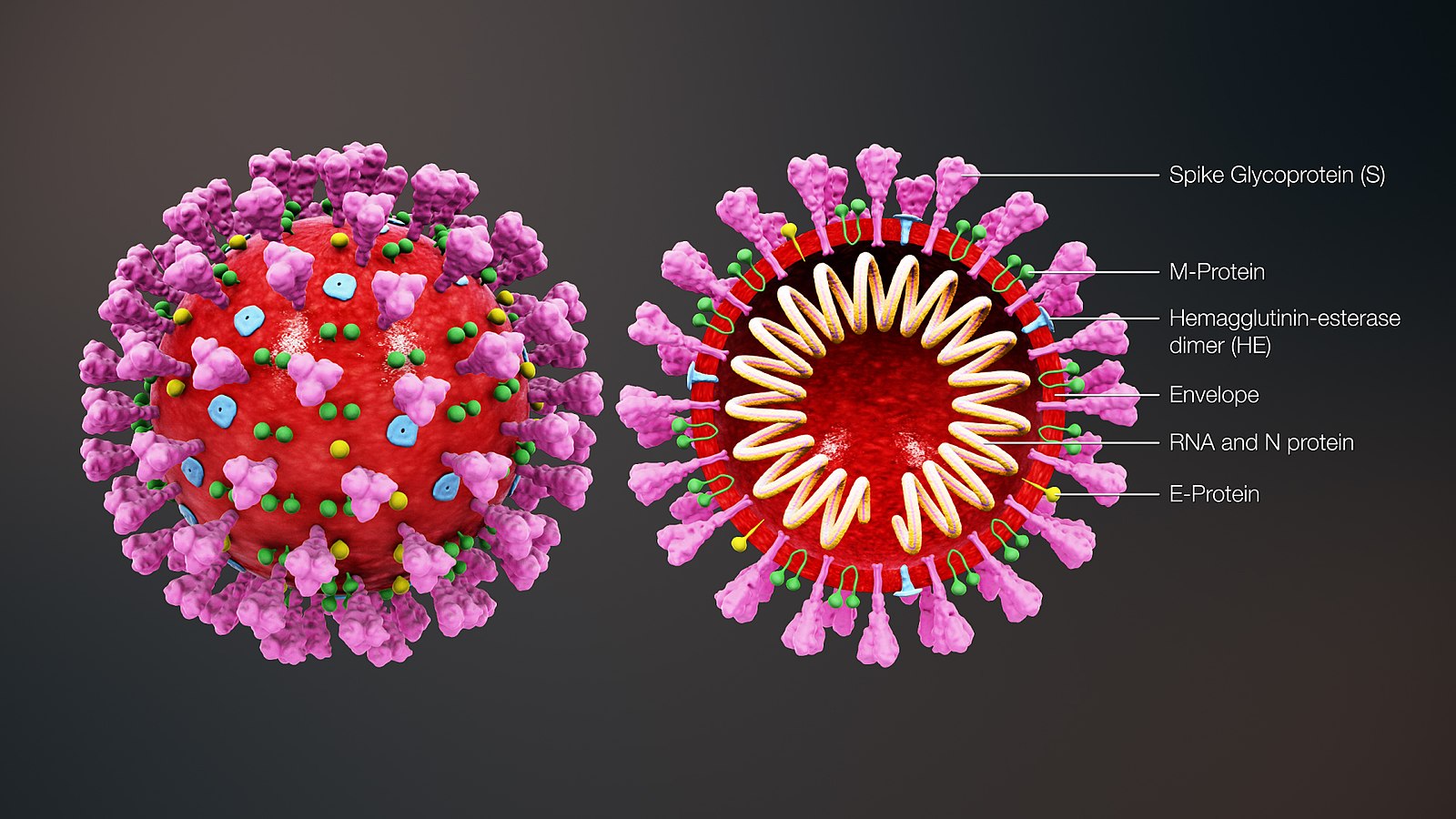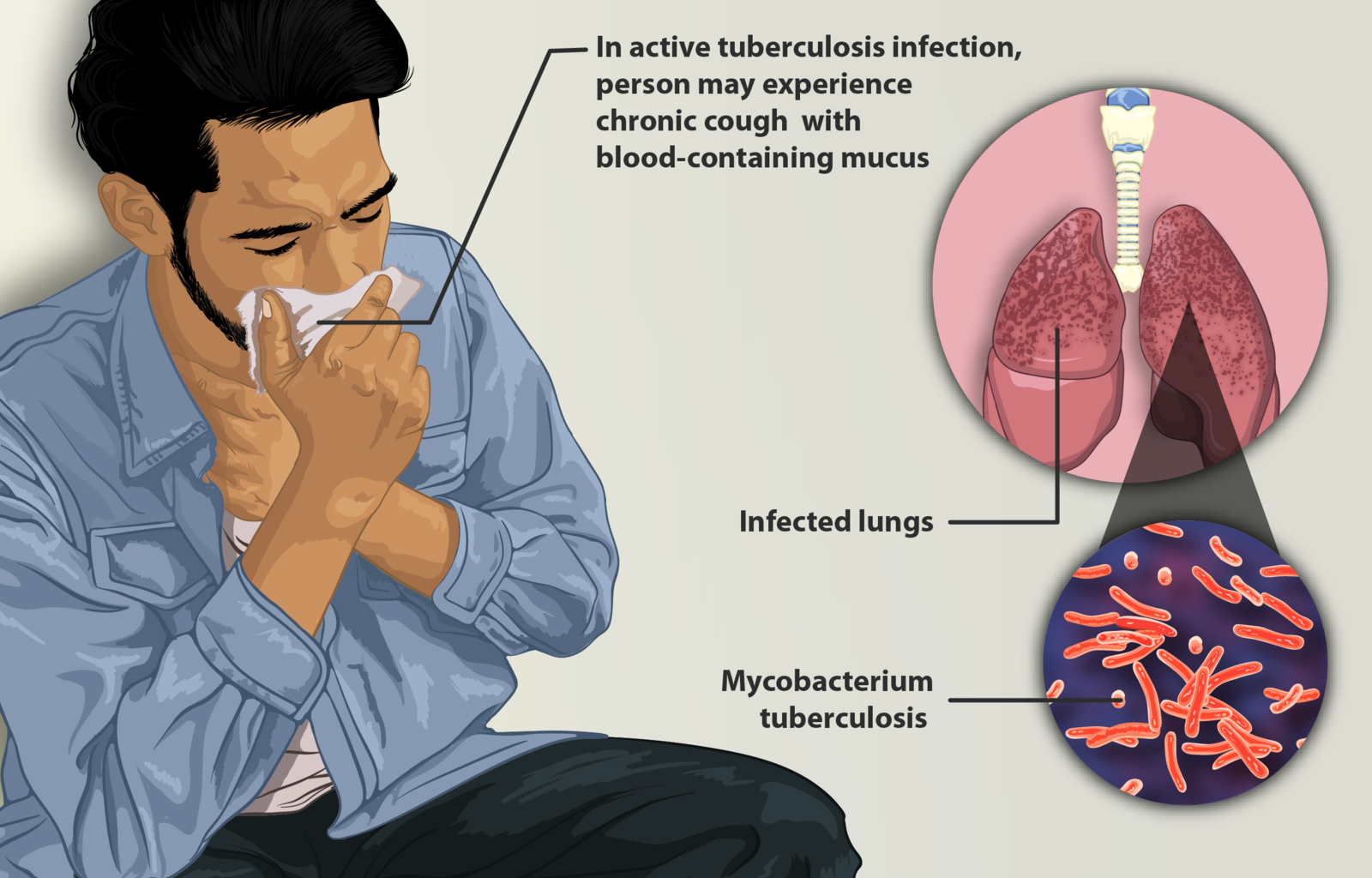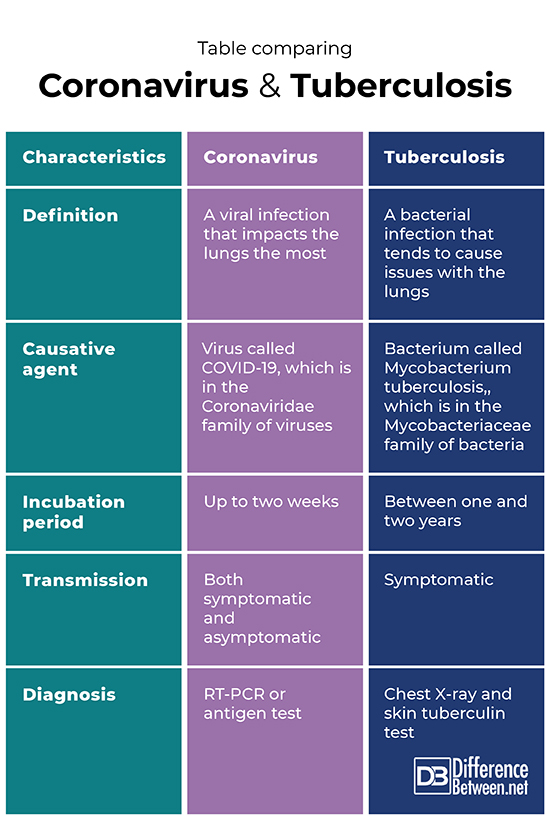Difference Between Coronavirus and Tuberculosis
Coronavirus is a viral infection caused by COVID-19. Tuberculosis is a bacterial infection caused by a mycobacterium.

What is Coronavirus?
Definition:
Coronavirus is the infection caused by the COVID-19 virus; this virus is causing a global pandemic.
Symptoms:
Some of the earliest symptoms of coronavirus in people are a high fever and a dry cough. The virus can severely compromise the ability of people to breathe due to lung damage that it causes. Many individuals who have been infected do not develop symptoms or only have mild symptoms.
Complications:
However, in extreme cases of infection, the virus causes damage to organs, including the kidney and heart, and people lose the ability to taste and smell; researchers have also found that patients in respiratory distress show abnormal blood clotting causing multiple organ failure, often leading to death.
Diagnosis:
Diagnosis of coronavirus is made with either an RT-PCR test or an antigen test. An RT-PCR test is done on a nasal or oral swab taken from the person who is thought to be infected.
Transmission:
COVID-19 is believed to have come from an animal host, originally, and then spread to humans. The transmission is highest in people with symptoms, but scientists now know that even asymptomatic people can transmit the disease, making control difficult.
Risk factors:
The people at highest risk are those living with and in close contact with infected individuals. Healthcare workers who treat such patients are particularly at high risk of infection. Males are also at higher risk than females. People with comorbidities such as diabetes and heart disease are at increased risk of severe illness if infected.
Mortality rate:
The case fatality rate seems to vary from country to country; for instance in Singapore it was estimated to be about 0.3%, while in Italy it was estimated to be 7.2%. Much of the differences in mortality rates are due to variation in age, with older individuals more likely to die after being infected, and Italy has an older population.
Treatment:
Pain killers can help with the discomfort and for some people, extra oxygen may be needed. There is no consensus on if anti-inflammatory or immune suppressant drugs are a good option. Vaccine trials have begun and it is thought that a vaccination strategy will be the best option for controlling the virus.

What is Tuberculosis?
Definition:
Tuberculosis is an infection by an organism called a mycobacterium, which most often impacts a person’s lungs. The illness tends to occur in three stages, primary infection, latent infection, and then active infection.
Symptoms:
In the active stage of the illness, symptoms can vary greatly from mild to severe. Even when mild the infected person may lose their appetite and lose weight; they also often feel very tired. As the illness worsens, the person coughs up sputum that is greenish or yellowish; once there is significant lung damage, the person coughs up blood. The individual may have a low grade fever and shortness of breath. The fact that the person is coughing may make it confusing since this is also a symptom of coronavirus.
Complications:
The condition can lead to many complications including problems with the joints and spine, liver and heart. A person can end up with septic shock, respiratory failure, and death.
Diagnosis:
The diagnosis of tuberculosis (TB) can be done by culturing the bacteria and doing an acid-fast stain. Chest x-rays and a positive TB skin tuberculin test is often used today to diagnose the condition.
Transmission:
The transmission of TB is largely due to a person expelling the bacterium in droplets when they cough, in other words when they are symptomatic and have an active illness. The long incubation period compared with COVID-19 is one reason that TB is considered to be less infectious and transmitted to fewer people as a result.
Risk factors:
Risk factors include being in contact with people who have active cases of TB; other individuals at high risk of TB include those with a compromised immune system; for instance, people with HIV who live where TB is prevalent. There is a vaccine, the Bacillus Calmette–Guérin vaccine, used to protect against TB; individuals who have had the BCG vaccine have some protection from TB, particularly disseminated TB.
Mortality rate:
The mortality rate from TB is about 10% of total cases, particularly in individuals who are already in a weakened state due to comorbidities. Some scientists believe that the mortality rate per case has been decreasing in recent years.
Treatment:
Treatment is an antibiotic regime, which needs to be strictly followed to avoid antibiotic resistance developing. People who become very ill often need care in a hospital setting.
Difference between Coronavirus andTuberculosis?
Definition
Coronavirus is a viral infection that adversely impacts the lungs. Tuberculosis is a bacterial infection that causes problems with the lungs.
Causative agent
The virus called COVID-19, in the Coronaviridae family of viruses, is the cause of coronavirus. The bacterium called Mycobacterium tuberculosis, in the Mycobacteriaceae family of bacteria, is the cause of TB.
Incubation period
The incubation period for coronavirus is about two weeks. The incubation period for TB is anywhere between one and two years.
Transmission
Coronavirus can be transmitted when a person has symptoms, but also when they are asymptomatic. TB is transmitted to others when a person who has TB displays symptoms of the infection.
Diagnosis
Coronavirus is diagnosed by an RT-PCR test or an antigen test. TB is diagnosed by a chest X-ray and skin tuberculin test.
Table comparing Coronavirus and Tuberculosis

Summary of Coronavirus Vs. Tuberculosis
- Coronavirus is caused by a virus that can be spread even before a person shows symptoms.
- Both coronavirus and tuberculosis infect the lungs, but the incubation time of the two illnesses is quite different, and TB does not spread as rapidly through a population.
- TB is caused by a bacterium and can be treated by antibiotics.
- There is a vaccine available for preventing tuberculosis, while there are currently clinical trials for a COVID-19 vaccine.
- Difference Between Constipation and Bowel Obstruction - April 3, 2024
- Difference Between Constipation and Diarrhea - March 30, 2024
- Difference Between Cellulite and Stretch Marks - March 25, 2024
Search DifferenceBetween.net :
References :
[0]Akpan, Nsikan. “new-coronavirus-spreading-between-humans-how-it-started”. National Geographic, 2020, https://www.nationalgeographic.com/science/2020/01/new-coronavirus-spreading-between-humans-how-it-started/
[1]Gandhi, Monica, Deborah S. Yokoe, and Diane V. Havlir. "Asymptomatic transmission, the Achilles’ heel of current strategies to control COVID-19." New England Journal of Medicine 382 (2020): 2158-2160.
[2]Young, Douglas B., Hannah P. Gideon, and Robert J. Wilkinson. "Eliminating latent tuberculosis." Trends in microbiology 17.5 (2009): 183-188.
[3]Image credit: https://commons.wikimedia.org/wiki/File:Depiction_of_a_tuberculosis_patient.png
[4]Image credit: https://commons.wikimedia.org/wiki/File:3D_medical_animation_coronavirus_structure.jpg
